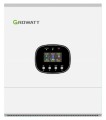Maximum efficiency
Inverter efficiency for solar panels.
The efficiency indicator is the percentage ratio between the amount of energy that the device delivers to the load and the energy consumed from the solar panel. The higher this parameter, the more efficient the operation of the device and the lower the losses during conversion. In modern inverters for solar panels, efficiency values of up to 90% are considered average, and above 90% are considered good.
Euro efficiency
The European inverter efficiency is measured based on several load values (e.g. 10%, 30%, 50%, 100%), which better reflects the actual operating conditions of the device. Indeed, in fact, inverters rarely operate at full power in constant mode. To calculate the Euro index, the weighted average of the inverter efficiency at different load levels is taken into account. Note that there is no single generally accepted formula here - it may vary depending on the specific standard or equipment manufacturer. Nevertheless, Euro efficiency allows you to more accurately assess the efficiency of the inverter under conditions of partial and full power use
Rated power
The rated output power of the inverter, expressed in volt-amperes (VA). Essentially, this value is equivalent to power in watts (W).
This parameter refers to the power that the device can continuously deliver to consumers. When choosing based on this parameter, ensure that the rated power of the inverter exceeds the expected load power by approximately 15-20%. Additionally, keep in mind that some electrical appliances (particularly those with electric motors, such as vacuum cleaners, refrigerators, etc.) consume significantly more energy at startup than during regular operation. For such loads, it's important to check the peak power of the inverter (see the relevant paragraph) — it should be higher than the starting power of the load.
Rated power
The rated output power of the inverter, expressed in watts (W).
This parameter means the power that the device can provide to consumers for an unlimited time. It is necessary to choose according to this indicator so that the rated power of the inverter covers the power consumption of the expected load by approximately 15-20%. It is also worth considering that some electrical appliances (in particular, units with electric motors - vacuum cleaners, refrigerators, etc.) consume significantly more energy when starting up than after entering the mode. For such a load, it is also necessary to clarify the peak power of the inverter (see the corresponding paragraph) - it should be higher than the starting power of the load.
Rated AC current
The current strength that the device is capable of stably and safely delivering when operating in rated mode (i.e. for the longest possible time without the risk of overloads and failures). The indicator is expressed in Amperes (A).
Maximum AC power
The maximum current in amperes (A) that the inverter, when operating, is capable of outputting without overloads or failures.
Number of battery inputs
Number of points for connecting batteries to the inverter. Household models usually have one such input, while powerful and productive models may have two or even three battery inputs. Multiple inputs allow the system to be scaled by adding batteries without having to replace the inverter.
Maximum charge current
The maximum amount of direct current in amperes that the inverter can convert. If the solar panel produces a current exceeding this value, the inverter simply does not use it. This is often justified when connecting an inverter to high-power solar panels - the maximum input current of the inverter is reduced to acceptable values so that moderate-sized wires can be used to transmit energy.
Max. power
The maximum allowable input power from solar panels, expressed in kilowatts (kW). Let us remember that 1 kW contains 1000 W.
When selecting an inverter based on this indicator, they are based on the total power of the solar panels involved in generating electricity. Moreover, it often makes sense to select models with an inverter input power slightly less than the maximum power of solar panels - for example, if they are shaded part of the time or for other reasons do not receive enough sunlight during the day. The power of the solar battery should not exceed the power of the inverter by more than 30%. However, for some inverters the excess can be only 10%, while for others it can be up to 100%. It is better to clarify this point in advance.

